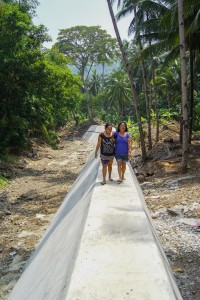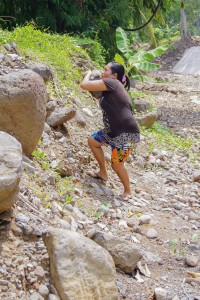
Sagay, Camiguin Province – Typhoon Yolanda, internationally known as Haiyan, affected a small town in this province but has paved way for heroines to arise, the spirit of volunteerism becoming evident more than ever.
Alfonsa Salva, 52, of Alangilan, Sagay town, Camiguin volunteered to spearhead the construction of a flood control structure along the Lambog River which is situated near a public school area.
Alfonsa, along with other women volunteers in her village initiated and oversaw the construction of a 70-meter flood control structure that will spare Alangilan Elementary School from the danger of flash floods during heavy downpour brought about by typhoons.
“This project prevents the raging flow of waters from the highlands during rainy season. This is the answer to our long standing dream of putting safety to our children who are enrolled at Alangilan Elementary School,” Alfonsa enthused.
The flood control structure was constructed under the Department of Social Welfare and Development program – the Kapit-Bisig Laban saKahirapan Comprehensive and Integrated Delivery of Social Services – National Community Driven Development Program (Kalahi CIDSS-NCDDP).
Alfonsa is a member of the procurement team of the village volunteers who facilitated in the purchasing of construction materials for the project, this among other tasks. The sub-project started in June 2015 and completed on early September of same year. She said that her tasks ranged from canvassing and facilitating bidding processes, and made sure everything is transparent with the different stakeholders.
Alfonsa also served as the timekeeper during the actual construction of the flood control structure, and helped oversee the entire project.
Helping Hands
Rodora Rementizo, 39, Alfonsa’s neighbor, also volunteered in the actual construction of the project. She also revealed that some of their friends also helped out, and there were about 10 women who volunteered during the construction.

Rodora said that one of the toughest tasks was during the clearing of the area which involved lifting rocks and setting them aside before the actual construction. She also enthused that she always listened to the construction foreman for instructions.

Seminars conducted through the Family Development Session of Pantawid Pamilya and Kalahi-CIDSS made Rodora realize that the participation of women in male-dominated projects is about how women are able to access power structures in the organized sub-project management committee and the difference they made out of such participation.
“During the construction, I help my fellow women volunteers prepare snacks and in the bidding process in procuring construction materials,” Rodora enthused.
Both Alfonsa and Rodora said that the sub-project management committees, who are all volunteers, were able to maintain transparency in the project implementation.
Rodora notes that back in the day, only the elite or wealthy women were actively involved in their village activities. However, poor women like her are now increasingly becoming active in school, church, and community activities.
“Before, we only look after the welfare of our children and husbands. Now, we still do that and we are more involved in the decision-making in our families and in our community,” Rodora concludes.
Kalahi-CIDSS is a community-driven development project that enables community members to have the power to plan, choose, implement, and monitor their own projects while Pantawid Pamilya invests on health and education of children by providing monthly cash grants to households complying with the conditionality of the program.
Written by: Shaun Alejandrae Yap Uy, DSWD


